This easy fermented fruit vinegar uses two ingredients: fruit and water. It's the perfect way to use fruit scraps and overripe fruit to make homemade apple cider vinegar, berry vinegar, and more!

I try really hard to not waste food.
A few years ago, as fruit season came into full swing, I started reassessing how much fruit was going into our tumbling composter.
And while yes, it's true that compost isn't exactly "wasting" anything, since the food scraps eventually get worked back into our garden, I still wanted to make the food work harder for us.
The answer seemed clear. I needed to make this the summer of fruit vinegar.
If you've been following along on my Instagram stories, you've probably seen my fruit vinegar in progress. Some of you have even asked about it.
This easy fruit vinegar tutorial is a perfect way to use extra fruit, overripe fruit, and fruit scraps to make your own homemade fermented fruit vinegar.
Can I Really Make Vinegar From Fruit?
You sure can!
All you need is fruit and water, and lacto-fermentation does the rest.
If you're new to fermenting, I recommend checking out the book Wild Fermentation by Sandor Katz.
Make sure to check out our other fermenting recipes too! Some of our most popular posts are tutorials for how to make kombucha, water kefir, milk kefir, yogurt (in a yogurt maker), Instant Pot yogurt, homemade sauerkraut, and red cabbage sauerkraut.
What Kind of Fruit (or Fruit Scraps) Can I Use for Vinegar?
Basically the answer is, if it's fruit, you can use it!
And also, fruit peels, fruit cores, or fruit pits. Especially when those fruit scraps still have bits of fruit attached to them.
You can use fresh, undamaged, perfect fruit, but this fruit vinegar really shines in its ability to take unwanted fruit and turn it into liquid gold.
Use fruit scraps, fruit peels, bruised fruit, and overripe fruit. If your fruit has a pit with bits of fruit still attached, you can use that too.
You can also used dried fruits.
The only rule here is to avoid using moldy fruit, because you don't want to encourage mold growth in your ferment.
Here are some of my favorite fruits to use:
- apple peels + cores
- strawberry hulls (the leafy green part + the top of the strawberry)
- cherry pits (Pit the cherries into the vinegar jar to catch all the juice.)
- overripe grapes, blueberries, raspberries, or blackberries (squash or cut them in half to get the juice out)
- citrus peels
You can also add fresh herbs or spices to the vinegar ferment. I like to add mint or basil to my strawberry vinegar.
What Equipment Do I Need?
The only thing you really need is a clean glass jar.
I like to use a 2-quart (half-gallon) jar, but you can go smaller or larger.
Technically, that's it. You don't need anything but a glass jar and something to cover the jar (like a paper towel and a rubber band).
That said, if you (like me) live in fear of summer fruit flies, you may want to buy a few airlock fermenting lids. These lids work on any standard wide-mouth glass jar, and do a wonderful job at keeping fruit flies out of ferments.
Can I Freeze Fruit Scraps Until I Have Enough?
Yes! Most definitely.
During the busy summer fruit season, I've been freezing scraps because I don't currently have enough jars and airlock lids to use all my scraps at once!
How to Make Fermented Fruit Vinegar
Start by filling a glass jar ¾ of the way full with fruit.
Add some herbs if you want to.
Do not fill the jar more than ¾ of the way full. As it ferments, the liquid will become active and bubble up.
If your jar is too full, it will overflow and create a mess.
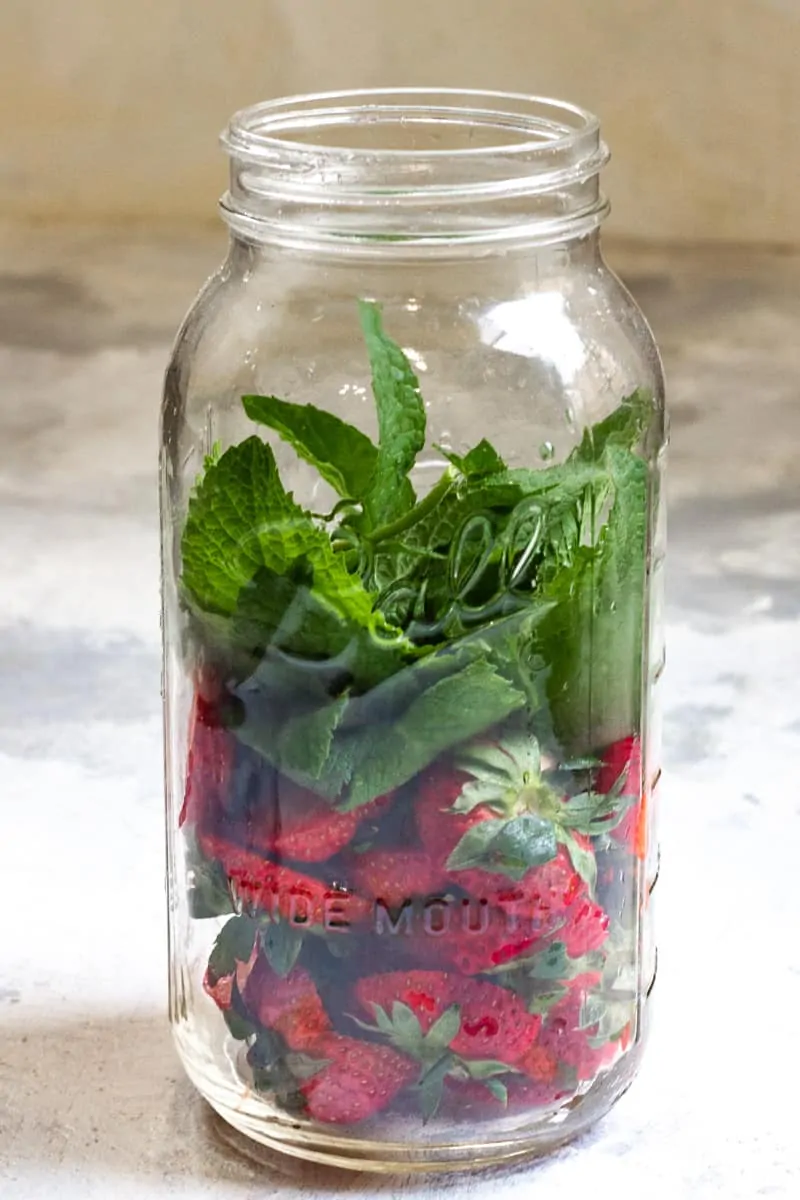
You may want to add something on top of the fruit to help keep it from floating above the water.
I like to use citrus peels, but you could also use a use fermenting weights or a small glass jar filled with water and sealed.
If you don't add a weight, that's fine too. You'll just want to keep a closer eye on your ferment and occasionally push the fruit below the water.
Next, cover the fruit with unchlorinated water.
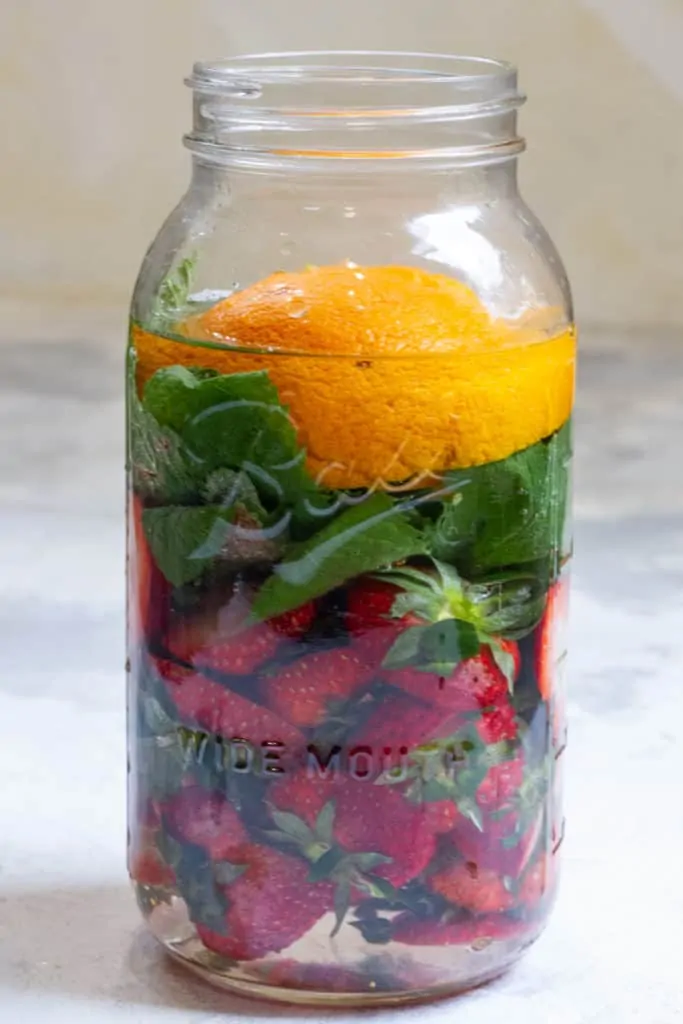
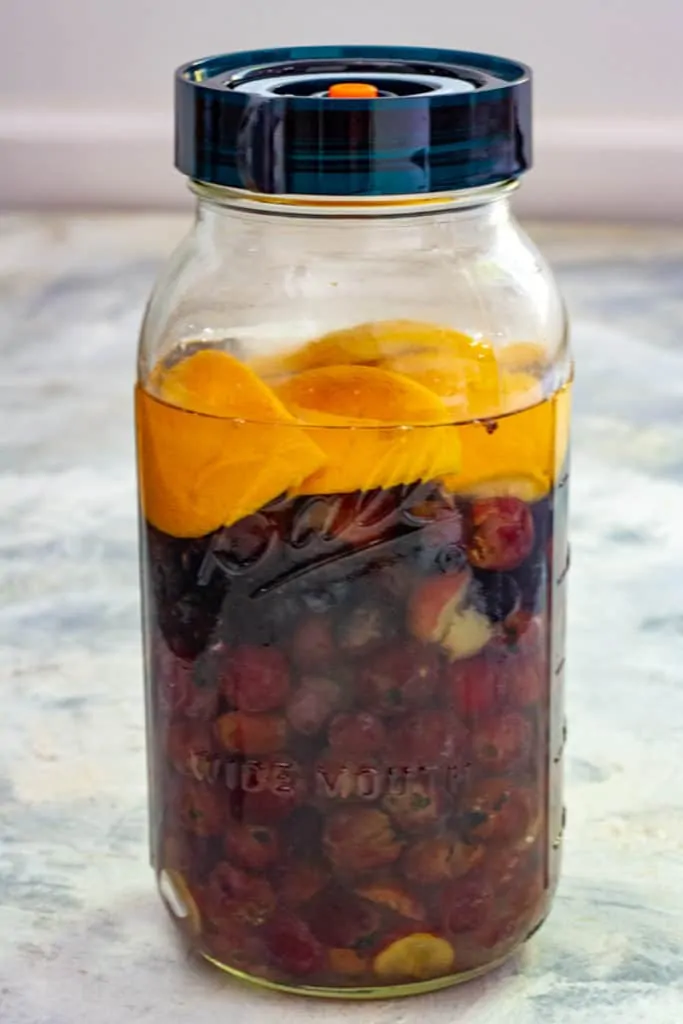
Cover the jar with one of your airlock fermenting lids, or use a paper towel and secure it with a rubber band.
Fruit Vinegar: The First Ferment
And now, you wait.
Fruit vinegar goes through two ferments. The first ferment (this one) lets the fruit infuse the water with flavor.
Let the fruit ferment for one to two weeks.
How do you know when the first ferment is finished?
As it ferments, the water will go from clear to very cloudy, and then will become clear again. When the water is clear again, you're ready to move onto the second ferment.

That said, some fruit vinegars will remain fairly cloudy, so it can sometimes be tricky to use the cloudiness of the water as a guide.
For example, apple cider vinegar is relatively cloudy even after fermenting.
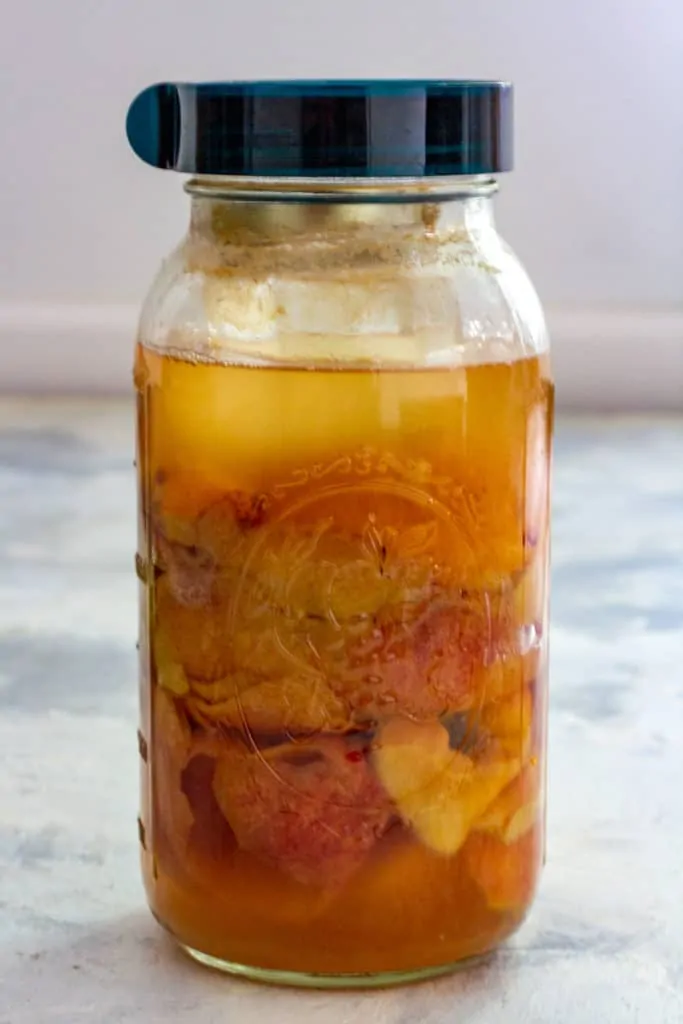
If the water doesn't seem to be clearing, move onto the second ferment after two weeks.
Fruit Vinegar: The Second Ferment
When the water becomes clear again (or after two weeks), it's time to move onto the next stage of the ferment.
Strain all of the fruit out of your vinegar. I usually strain mine through a mesh sieve into another container.
Clean out the glass jar, and pour the liquid back into the jar.
Cover the jar again.


Now the question is, how long do I have to ferment this vinegar?
There are two options. One option is "fast" (if you can call two-plus weeks fast), and the other will take more time.
Fermenting + Refrigerating
Option one: Let the vinegar ferment until you like the flavor and then refrigerate it.
I love this option, and it's my preferred method for a sweeter vinegar.
After straining out the fruit, I recommend fermenting it for at least two more weeks.
At this point, you can smell and taste the vinegar periodically. When you like the flavor, pour the vinegar into a glass bottle and stick it into the fridge.
Storing the vinegar in the fridge will drastically slow fermentation, and your vinegar will continue to taste like it did when you put it in the fridge.
Fermenting for Room Temperature Storage
If you continue to leave the vinegar at room temperature, it will continue to ferment. It will also become less sweet.
As the vinegar continues to ferment, the bacteria inside will gradually become less active.
If you have the counterspace and the desire, you could let the vinegar just do its thing. Be aware that this could take months.
To test the vinegar for "doneness," pour it into a bottle and seal it.
I recommend using pressure-resistant bottles for this step (like a beer growler, used kombucha bottles, or pressure-resistant swing-top bottles meant for kombucha or beer).
Bottles that aren't pressure resistant could burst if there is still a lot of fermentation happening.
Leave the bottle sealed for about a day. If it hasn't begun to carbonate, test it again in a few days.
When there is no carbonation, you can leave the lid on and store your vinegar at room temperature.
Does Temperature Matter When Fermenting Vinegar?
Yes, it does!
Ideally, the room you ferment your vinegar in should be between 55 and 75 degrees Fahrenheit.
Keep in mind that cold slows fermentation and heat speeds fermentation.
If your vinegar doesn't seem to be fermenting well, try moving it to a warmer space. If it's fermenting too quickly, try finding a cooler space.
Troubleshooting: Mold Growing in the Vinegar
In general, you won't have problems with mold growing if you keep the fruit pushed below the water level.
If you see cloudy things growing in the bottom of your vinegar, it's probably the vinegar mother forming. The vinegar mother helps the good bacteria grow, so it's a good thing.
If you see white residue forming on the top of the vinegar, simply skim it off.
However, in the unlikely event that you see actual mold growing in your vinegar AND your fruit was kept below the water at all times, you'll want to discard the vinegar.
What could cause mold growth? Three things.
A lack of airflow. Avoid storing your vinegar in the back of a musty cabinet.
Mold in your home. Again, put the vinegar in a place where there is airflow.
It was too hot to ferment. If your home is above 75 degrees Fahrenheit in the summer, I recommend storing your fruit scraps in the freezer and waiting to make vinegar a cooler time of year.
How to Store Fruit Vinegar
I like to use glass bottles with cork lids (like these decorative apothecary bottles) or pressure-resistant swing-top bottles.
But really, you could use any any glass container.
Keep in mind that the vinegar will cause metal lids (like the ones that come with canning jars) to rust.
How to Use Fruit Vinegar
You'll find that lots of recipes call for apple cider vinegar! For example, I use it with roasted brussels sprouts and braised kale, and it's delicious in a maple vinaigrette.
If you're making a different type of fruit vinegar, you can try swapping the fruit vinegar for apple cider vinegar in recipes.
Additionally, when recipes call for lemon juice or rice vinegar, but those ingredients are not pivotal, main ingredients, I often swap the listed ingredient for fruit vinegar.
You can also use fruit vinegar to make a shrub drink by adding a splash (or more) of vinegar to a glass with water or seltzer water. It's surprisingly refreshing!
If a batch of fruit vinegar turns out less delicious than you expected (because it fermented in temperatures that were too hot or you simply don't like the flavor with certain fruits), you can always mix the vinegar with some water and use it to fertilize your garden.
It's also worth noting that you should not use homemade vinegar for canning recipes, because you (probably) aren't testing the acidity level.
If you tried making homemade fruit vinegar, let me know what kind you made in the comments!
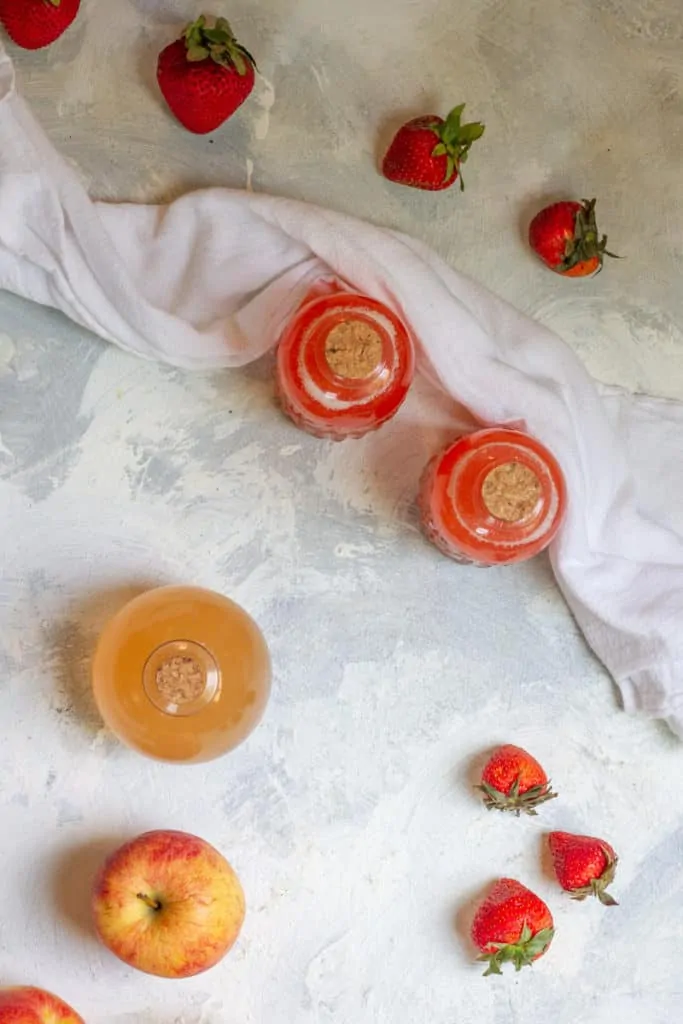
Fruit Vinegar
Equipment
- Large Glass Jar (2 quarts recommended)
Ingredients
- 6 cups fruit and / or fruit scraps Measurement an estimate. Use enough fruit to fill a jar ½ or ¾ full.
- herbs or spices (optional)
- 1 orange peel (optional)
Instructions
First Ferment:
- Fill the jar ½ to ¾ full with fruit and any herbs or spices. Do not fill the jar completely.

- Weigh the Fruit Down:If desired, top fruit with the orange peel. Alternatively, you can use fermenting weights or a small glass jar filled with water and sealed.When to Skip the Weight: If your fruit is heavy, or already has large sections of thick peel, you can probably get away with using its own peel as a weight. (Ex: For mango vinegar, I use a few layers of mango peel to weigh down the vinegar.) If the fruit tends to float (as with apples, berries, or grapes), I recommend using an orange peel or other weight.
- Fill the jar with unchlorinated water. The water should be an inch or two above the fruit, but there should still be a 2"-4" space in between the water and the top of the jar.Cover the jar with a paper towel or tea towel, and secure with a rubber band. Alternatively, use an airlock fermenting lid (to help prevent fruit flies).Do not seal the jar with a lid (such as a canning lid). The vinegar needs airflow.
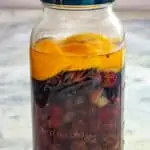
- Store the jar out of direct sunlight for 1-2 weeks. Check on the fruit daily to make sure it's staying below the water line. If any fruit pops up above the water, push it down.As the ferment continues, the water will change from clear to cloudy to clear again. Note that some fruit vinegars will always appear cloudy, so if your water doesn't change from cloudy to clear, go ahead and move on to the next step after two weeks.
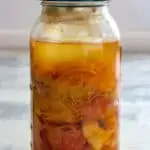
Second Ferment:
- Strain the fruit out of the liquid. I usually set a mesh sieve above another container and pour the vinegar through it.Discard or compost the fruit. Clean the jar, and pour the vinegar back into the jar. Recover the jar with the paper towel and rubber band or the airlock fermenting lid.Again, do not seal the jar with a lid (such as a canning lid). The vinegar needs airflow.
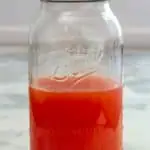
- Two Week Ferment + Refrigerate the Vinegar:For a relatively sweet vinegar, let the vinegar ferment for at least two more weeks or until you like the flavor, and then store in the fridge.Longer Ferment + Shelf-Stable Vinegar:For a more acidic vinegar, let the vinegar continue to ferment until the bacteria in the vinegar is finished fermenting. This may take several months.To test the vinegar for doneness, pour it into a pressure-resistant bottle and seal the bottle. Wait 24 hours and open the bottle. If the vinegar has begun to carbonate, let it ferment in the jar longer. If it hasn't, try sealing it in the pressure-resistant bottle again for a few days. When there are no signs of carbonation, the vinegar is done. Store it at room temperature and use as desired.Use vinegar within 6 months for the best flavor.
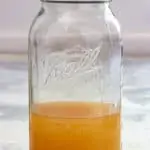

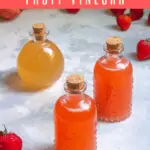

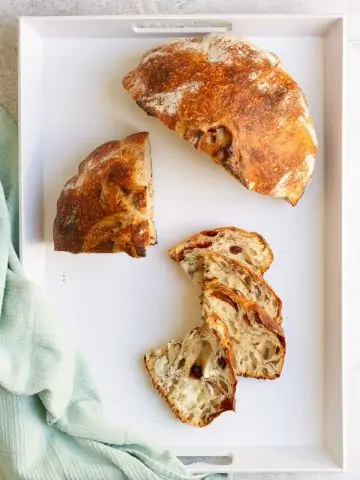
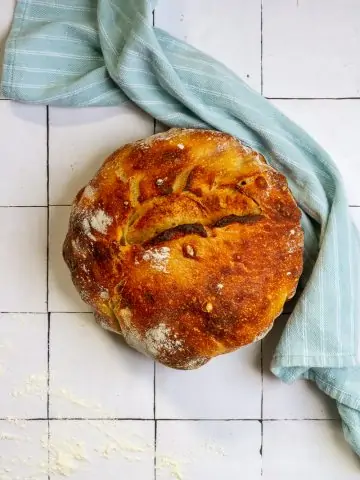
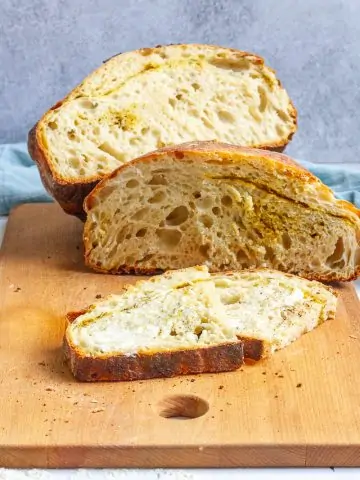
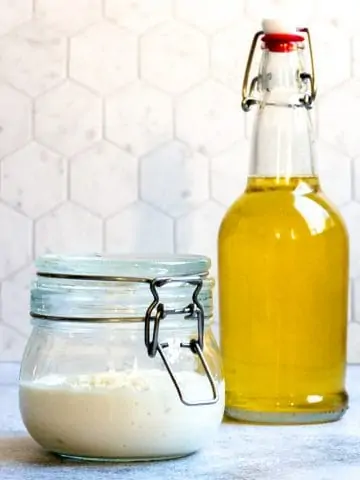
Shelley
Wow I'm fascinated by this! Can't wait to try it as I have a generous amount of apple and strawberry scraps year round. Thanks!
Sarah Trenalone
Yay! I hope you enjoy it 🙂
Linda Todd
I'm experimenting with pineapple and black berry vinegars. I'm anxious to use the final results and try other fruits from our yard such as persimmon, and plum. Thank you for your explanation and directions which are beneficial!
Sarah Trenalone
That all sounds delicious!! I hope you enjoy ☺️
Linda Todd
I've noticed most poneapple vinegar recipes take sugar but this does not, would you explain why not?
Sarah Trenalone
You could definitely try adding sugar! The pineapple should have plenty of natural sugars though, more than enough to start the lacto-fermentation. But experiment and see what you like best!
Lisa S
Sarah,
I had an abundance of (sand) pears this summer. They came early and in profusion. I canned a variety of jams and sauces and decided to take a stab at fruit vinegars. One batch I made all natural. The other I use a apple cider bump. The experiment started in August. I strained all the fruit scraps a month ago and have let them rest -well ventilated. This morning when I moved them into the kitchen in prep to strain/seive and bottle, I dislodged the mothers, which fell to the bottom of the glass jars. This made tasting easier. Both solutions are quite MILD and do not have a particularly vinegary flavor. I am not sure if I should feed them and wait another 2 weeks? And feed them with what? I still have some pears high on the tree, so I could use fruit. I did not add any sugar to the original set-ups. I'd appreciate any guidance. I am a master canner but this is my first foray into vinegar.
Sarah Trenalone
Hi Lisa,
Your vinegars might just need to ferment longer! Depending on how much sugar the fruit has and the temperature you ferment, the times can vary a lot. If it were me, I'd just let it keep going (with the mother). You could definitely add more fruit to punch up the flavor or infuse more sugar. Also, homemade vinegars generally aren't quite as acidic as store-bought (that's why they're not safe for canning). I hope it turns out delicious for you!
Jeff Gibson
My pineapple vinegar turns out pretty acidic. Usually around 3.5 pH. The longer it sets the stronger the flavor.
ien
Hey, thanks for this tutorial Sarah. I tried this same thing, using Sandor Katz's recipe. I'm not sure when I started it, but at least two weeks ago. I just strained out the orange peices I used today. I did not weigh them down, and there was a very healthy, bloom of mold on the orange peel floating on the surface. I figure I'd just wait and see now that its strained if the mold contaminated the liquid at all, before I taste it.
Sarah Trenalone
Hey Ien,
Happy to help! As for your vinegar, if it was white (white scum), it's probably fine. If it was mold, I'd probably toss it out.
It's helpful to check on the vinegar daily (even though that seems like a pain sometimes!) to make sure that everything is submerged below the water. That said, I often use orange peels as a weight and let them pop up above the liquid without problems. If it was mold, it's possible that there was already some mold on the fruit or orange peel before you started, that there is mold in your environment, or that spot you fermented in was too warm.
I hope that helps!
Jenny R.
I strained my plum ferment for second fermentation but there is quite a bit of cloudy, fuffly plum bits that have settled on the bottom. The particles were too small and went right through the wire mesh strainer. Can I leave those in there for the second ferment or strain it through a thin cheesecloth and remove? I don't want to strain out any mother that might be just getting going. I do plan to filter the vinegar when it is done and remove the mother at finishing. Also, should I stir at all during second ferment?
Alisha Trenalone
Hi Jenny! Some fruit vinegars tend to remain cloudy, and if the pieces are that small you probably don't need to worry about that too much. You shouldn't need to stir. Hope this helps!
-Alisha at Champagne Tastes
Nico
HI, I have been searching for an article like this for a while - I started the ferment about 3 weeks ago and it is so exciting to observe the transformation! I did 3 types = Dehydrated Blueberry, Apple and Dehydrated GOJI Berry! The Goji is the most active, it has the most natural sugar content, but also a beautiful color. My questions is, the berry seems to have kind of evaporated... or melted... and the seeds are floating around. There was the white film you mentioned and a pink cloud (guessing mother?) - it smells a bit "yeasty" - is that what the white stuff is? Is it dangerous? It seems some fermentations use yeast as a starter... If I just wait long enough and let it do it's thing... should I just expect it to goto that stage two?
What do you think? It's so pretty I don't want to dump it. 🙁 The blueberry is gorgeous too! Thanks for this post!
Sarah Trenalone
Hi! Yes the cloudy part should be the mother forming. The white residue is probably kahm yeast, which is harmless but I usually try to scrape it off. I'd recommend scraping it off! If you can't get it all, you could strain it through a mesh sieve or cheesecloth when you're moving it to the next ferment 😀 Glad you're having fun with!
Nina
Hi, can I mix pears and apples in the same vinegar recipe? Thanks!
Alisha Trenalone
Hi, Nina, yes you can! Hope you enjoy 🙂
-Alisha at Champagne Tastes
Shehryar Siddiqi
Is it ok to eat the fruit scraps after being done with the first ferment?
Alisha Trenalone
Hello! It should be ok, in theory. We haven't tried it out, but usually just compost the scraps.
Thanks for getting in touch!
-Alisha at Champagne Tastes
Karin
Is this like the type of fruit vinegar sold in Korean stores?
Alisha Trenalone
Hi Karin, sorry, I'm not sure. It's a variation of apple cider vinegar, if that helps!
-Alisha at Champagne Tastes
Barbara
I have a freeze dryer and I freeze dry a lot of fruit blend it up put it in jars keep it and use it every day in a smoothie could I take some of those freeze dried berries and fruit which is a lot of different kind and use that instead of fresh fruit Will it turn to vinegar and if so how much do you think I should add to the water
Sarah Trenalone
Hi Barbara,
I've never tried using dried fruit so I'm really not sure! But if you try it, let me know how it turns out 🙂
Adrienne Parlee
I covered some little hawthorn 'apple's' in water and stewed them for a minute just for an experiment. It tasted good. Could I make vinegar from this liquid when it's been 'cooked' for a min. ?
Alisha Trenalone
We haven't tested fermenting cooked fruit, so we're not sure, sorry! But if you try it let us know how it turns out.
-Alisha at Champagne Tastes
Adrienne Parlee
I found a hawthorn chutney recipe with raisins. I'll use the stewed hawthorn apples for that, and start picking more hawthorn apples to try to make vinegar. Thanks for the vinegar recipes that I can make without adding any sugar, the way they did it in the old days.
Elli Lavon
Hi! I am testing out tomato vinegar and white grape as my first batches. the tomato definitely has the white film on the surface and I am not sure if its mold/if its okay. I have not thrown it out yet bc i am holding out some hope itll be okay. the white grape seems to be doing amazing and it smells like wine which i am excited about. i bought fermentation weights bc the grapes keep popping up but it doesnt seem to have an issue. next is plum vinegar! all my ingredients were purchased from my local farmers market
Alisha Trenalone
Glad you're having a good time experimenting with different kinds of fruit vinegar! The white grape version sounds really good. As for the white film on the tomato vinegar, it may just be a residue that can be skimmed off.
Plum vinegar sounds nice too!
-Alisha at Champagne Tastes
Elli Lavon
my plum vinegar had a few mold spots on the top which i skimmed off, as well as white specks that form almost everyday that i also skim off. Has the entire batch been compromised because of the few mold spots?
Alisha Trenalone
If you're convinced it's mold and not just the usual white residue, then I would toss out the vinegar. You can try troubleshooting what went wrong based on the notes in the recipe post. Hope the next one works out better!
-Alisha at Champagne Tastes
J
Hi I did a white peach vinegar and it doesn’t taste as acidic as the pear vinegar I did. I was wondering if I should try to ferment longer or if I kept it out too long…
Sarah Trenalone
Hi! The peaches probably had a different (higher) sugar content than the pears. I'd try leaving it a little longer!
David
is that the same for Lemon Vinegar? My two jars of lemon vinegar (in progress) is only forming some scum at the top, not mold, but like a white film and some types of bubbles, as my other jars of mangos, pineapple etc make bubbles on top and inside and have a booze smell right now. My jars of lemon, do not smell boozy. Does it take longer for highly acidic fruits such as lemons?
Alisha Trenalone
Hi David! Thanks for your question. This process relies on natural sugars in the fruit, and our guess is that the lemons just don't have enough natural sugar to make this work. You'd probably need to add sugar to the liquid. But we haven't personally tested a version like that yet, so can't tell you for sure how it would go. Sorry about that!
-Alisha at Champagne Tastes
Dee
Thank you for this guide. I'm currently making a Mango vinegar, it has gotten pretty cloudy and I've been stirring everyday as I didn't use the glass weights to keep the fruit down. My worry is that as I was mixing today the liquid feels thick... I've been goodgling everywhere and can't find a reason as to why. And so I stumbled upon your page. Which is awesome btw! As silly as this may sound how would I know if there's mold growing? And is the thick cloudy water normal? Any advice would be great. I used 1 qt, 1/2 cup sugar 1 very overripe Mango (most likely began naturally fermenting as it tasted like alcohol) and distilled water. T.I.A.
Alisha Trenalone
Hi Dee! Cloudy water is normal, especially within the first ferment of one to two weeks. And some fruit vinegars also just remain cloudy.
Mold can happen, but it's not that common if the fruit has been kept below the water level and the temperature in your home is not too hot and there's decent air flow. IF there's mold, you might notice it on the fruit or floating on the top of the liquid. However, if it's a white residue, it may just be a yeast that can be skimmed off.
Hope this helps!
-Alisha at Champagne Tastes
shima
hye..do i need to cover the jug with cheese cloth to start the 2nd fermentation,or just use the close lid?
Alisha Trenalone
Hello! You should cover the jar with a paper towel and rubber band, or an airlock fermenting lid. Don't use a regular lid, as the vinegar needs airflow! Hope this helps.
-Alisha at Champagne Tastes
Loraine
Thanks for this article. My apple vinegar is done and my Pineapple vinegar and my Raisin vinegar are in the second week of the first fermentation. Both are getting less cloudy and have stopped bubbling. Is it time to move on strain and move on to the second fermentation? Also, I have 2 large mothers from the Apple vinegar. Can I put pieces of mother in the jars of the Pineapple and Raisin vinegar to help speed things along?
Alisha Trenalone
Hi Loraine, if your vinegars have stopped bubbling, then yes, I’d move on to the next step. And we haven’t tried adding an apple cider vinegar mother, but it’s worth a try. It shouldn’t hurt anything!
-Alisha at Champagne Tastes
Richelle Barlow
I’m making vinegar for the first time and ended up with several gallon size batches. I’m in the second ferment but several of the jars have a white film on the top. I already strained once, and placed in a new jar. One jar is definitely forming a mother, but the others just have this white film on top. At first I thought maybe it was a mother forming, but now the white film is on the sides of the jar. It’s not mold, and it doesn’t smell bad. Any thoughts on how to totally get rid of it if it’s yeast?
Alisha Trenalone
Hi Richelle. Yeah, the white residue is probably yeast, which is harmless but we usually do try to scrape it off. If you can’t get it all, you could do some more straining. We don't really have any other tips! Hope it turns out well.
-Alisha at Champagne Tastes
John
Hi Alisha,
Thanks for this informative site and to the questions from newbies like me.
I wish I had read this before starting several half gallon Mason jars up to the rim. First batch and it has made quite a mess overflowing. At least it is bubbling. Thank you again for the education, tips and tricks from experience you are offering.
John
Hi from Corsica
Thank you! I have a batch of fruit from my garden's strawberry trees (Arbutus unedo), and I want to try to make vinegar with it. I've looked up lots of recipes and explanations, but this is by far the clearest and most complete I've found. Bookmarked for future uses too. Hats off and thanks again!
Alisha Trenalone
You're so welcome! We hope it works out well for you!
-Alisha at Champagne Tastes
Nicole Rutherford
I’m planning to make a persimmon vinegar with some very ripe and soft fuyu persimmons. Thanks for this recipe! In the 2nd ferment, if you want to use some of it while it is moving toward shelf stable phase, is that ok?
Thanks!!
Alisha Trenalone
If you like the flavor at that point, that should be fine! Hope it turns out well 😀
-Alisha at Champagne Tastes
Ellen
Wow, this recipe was divine intervention because I just finished hulling a flat of strawberries and wondered if there was any other use, besides composting, that I could try to utilize the scraps. I followed your instructions to the letter and cannot wait to enjoy some wonderful strawberry vinegar on summer salads.
Alisha Trenalone
So thrilled this worked for you!!
-Alisha at Champagne Tastes